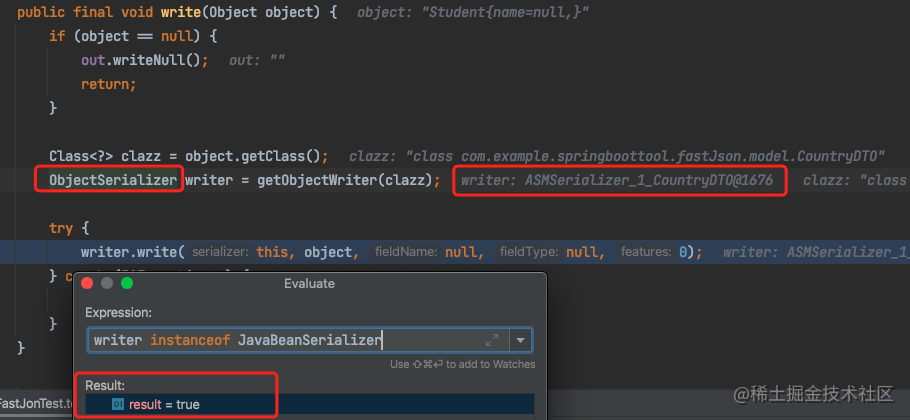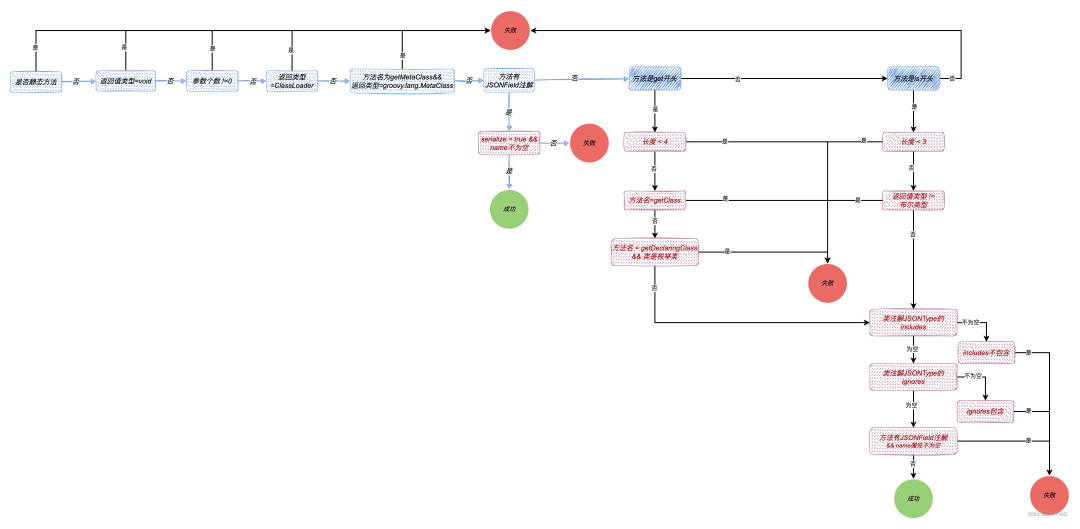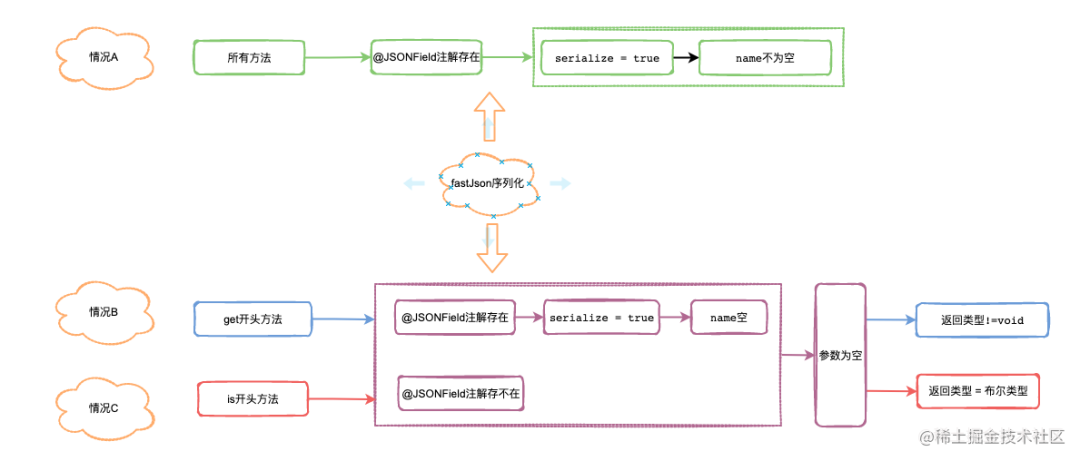01、线上事故回顾
前段时间新增一个特别简单的功能,晚上上线前review代码时想到公司拼搏进取的价值观临时加一行 log 日志,觉得就一行简单的日志基本上没啥问题,结果刚上完线后一堆报警,赶紧回滚了代码,找到问题删除了添加日志的代码,重新上线完毕。
02、情景还原
定义了一个 CountryDTO
public class CountryDTO { private String country;
public void setCountry(String country) { this.country = country; }
public String getCountry() { return this.country; }
public Boolean isChinaName() { return this.country.equals("中国"); }}
复制代码
定义测试类 FastJonTest
public class FastJonTest { @Test public void testSerialize() { CountryDTO countryDTO = new CountryDTO(); String str = JSON.toJSONString(countryDTO); System.out.println(str); }}
复制代码
运行时报空指针错误:
通过报错信息可以看出来是 序列化的过程中执行了 isChinaName()方法,这时候this.country变量为空, 那么问题来了:
序列化为什么会执行isChinaName()呢?
引申一下,序列化过程中会执行那些方法呢?
03、源码分析
通过 debug 观察调用链路的堆栈信息
调用链中的ASMSerializer_1_CountryDTO.write是FastJson使用asm技术动态生成了一个类ASMSerializer_1_CountryDTO,
asm 技术其中一项使用场景就是通过到动态生成类用来代替java反射,从而避免重复执行时的反射开销
04、JavaBeanSerizlier 序列化原理
通过下图看出序列化的过程中,主要是调用JavaBeanSerializer类的write()方法。
而JavaBeanSerializer 主要是通过 getObjectWriter()方法获取,通过对getObjectWriter()执行过程的调试,找到比较关键的com.alibaba.fastjson.serializer.SerializeConfig#createJavaBeanSerializer方法,进而找到 com.alibaba.fastjson.util.TypeUtils#computeGetters
public static List<FieldInfo> computeGetters(Class<?> clazz, // JSONType jsonType, // Map<String,String> aliasMap, // Map<String,Field> fieldCacheMap, // boolean sorted, // PropertyNamingStrategy propertyNamingStrategy // ){ //省略部分代码.... Method[] methods = clazz.getMethods(); for(Method method : methods){ //省略部分代码... if(method.getReturnType().equals(Void.TYPE)){ continue; } if(method.getParameterTypes().length != 0){ continue; } //省略部分代码... JSONField annotation = TypeUtils.getAnnotation(method, JSONField.class); //省略部分代码... if(annotation != null){ if(!annotation.serialize()){ continue; } if(annotation.name().length() != 0){ //省略部分代码... } } if(methodName.startsWith("get")){ //省略部分代码... } if(methodName.startsWith("is")){ //省略部分代码... } }}
复制代码
从代码中大致分为三种情况:
05、序列化流程图
06、示例代码
/** * case1: @JSONField(serialize = false) * case2: getXxx()返回值为void * case3: isXxx()返回值不等于布尔类型 * case4: @JSONType(ignores = "xxx") */@JSONType(ignores = "otherName")public class CountryDTO { private String country;
public void setCountry(String country) { this.country = country; }
public String getCountry() { return this.country; }
public static void queryCountryList() { System.out.println("queryCountryList()执行!!"); }
public Boolean isChinaName() { System.out.println("isChinaName()执行!!"); return true; }
public String getEnglishName() { System.out.println("getEnglishName()执行!!"); return "lucy"; }
public String getOtherName() { System.out.println("getOtherName()执行!!"); return "lucy"; }
/** * case1: @JSONField(serialize = false) */ @JSONField(serialize = false) public String getEnglishName2() { System.out.println("getEnglishName2()执行!!"); return "lucy"; }
/** * case2: getXxx()返回值为void */ public void getEnglishName3() { System.out.println("getEnglishName3()执行!!"); }
/** * case3: isXxx()返回值不等于布尔类型 */ public String isChinaName2() { System.out.println("isChinaName2()执行!!"); return "isChinaName2"; }}
复制代码
运行结果为:
isChinaName()执行!!getEnglishName()执行!!{"chinaName":true,"englishName":"lucy"}
复制代码
07、代码规范
可以看出来序列化的规则还是很多的,比如有时需要关注返回值,有时需要关注参数个数,有时需要关注@JSONType注解,有时需要关注@JSONField注解;当一个事物的判别方式有多种的时候,由于团队人员掌握知识点的程度不一样,这个方差很容易导致代码问题,所以尽量有一种推荐方案。这里推荐使用@JSONField(serialize = false)来显式的标注方法不参与序列化,下面是使用推荐方案后的代码,是不是一眼就能看出来哪些方法不需要参与序列化了。
public class CountryDTO { private String country;
public void setCountry(String country) { this.country = country; }
public String getCountry() { return this.country; }
@JSONField(serialize = false) public static void queryCountryList() { System.out.println("queryCountryList()执行!!"); }
public Boolean isChinaName() { System.out.println("isChinaName()执行!!"); return true; }
public String getEnglishName() { System.out.println("getEnglishName()执行!!"); return "lucy"; }
@JSONField(serialize = false) public String getOtherName() { System.out.println("getOtherName()执行!!"); return "lucy"; }
@JSONField(serialize = false) public String getEnglishName2() { System.out.println("getEnglishName2()执行!!"); return "lucy"; }
@JSONField(serialize = false) public void getEnglishName3() { System.out.println("getEnglishName3()执行!!"); }
@JSONField(serialize = false) public String isChinaName2() { System.out.println("isChinaName2()执行!!"); return "isChinaName2"; }}
复制代码
08、三个频率高的序列化的情况
以上流程基本遵循 发现问题 --> 原理分析 --> 解决问题 --> 升华(编程规范)。
















评论